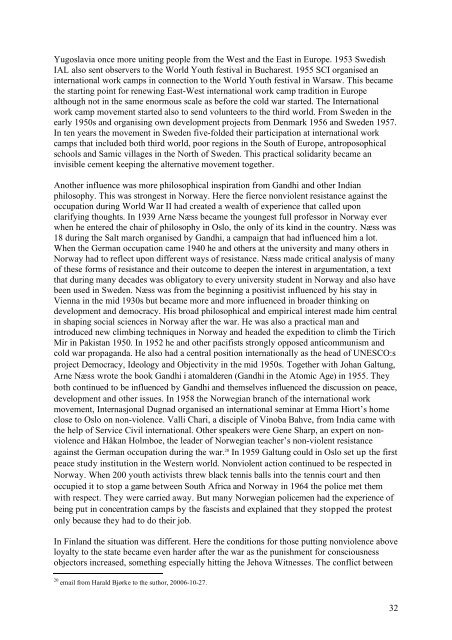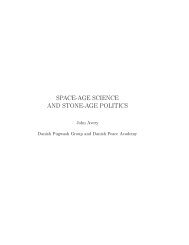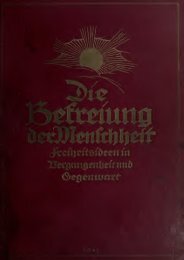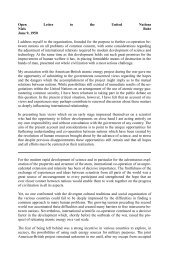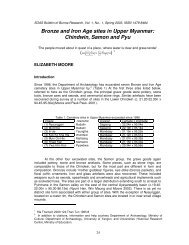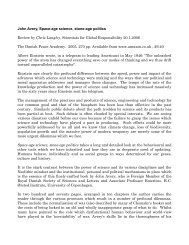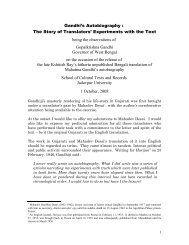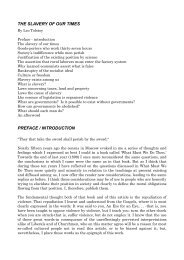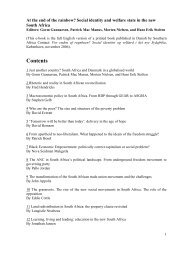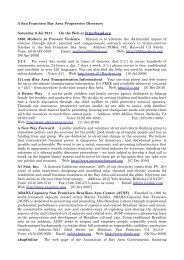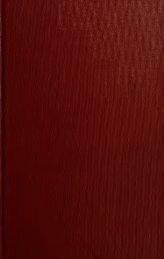Indian-Nordic Encounters 1917-2006 - Det danske Fredsakademi
Indian-Nordic Encounters 1917-2006 - Det danske Fredsakademi
Indian-Nordic Encounters 1917-2006 - Det danske Fredsakademi
You also want an ePaper? Increase the reach of your titles
YUMPU automatically turns print PDFs into web optimized ePapers that Google loves.
Yugoslavia once more uniting people from the West and the East in Europe. 1953 Swedish<br />
IAL also sent observers to the World Youth festival in Bucharest. 1955 SCI organised an<br />
international work camps in connection to the World Youth festival in Warsaw. This became<br />
the starting point for renewing East-West international work camp tradition in Europe<br />
although not in the same enormous scale as before the cold war started. The International<br />
work camp movement started also to send volunteers to the third world. From Sweden in the<br />
early 1950s and organising own development projects from Denmark 1956 and Sweden 1957.<br />
In ten years the movement in Sweden five-folded their participation at international work<br />
camps that included both third world, poor regions in the South of Europe, antroposophical<br />
schools and Samic villages in the North of Sweden. This practical solidarity became an<br />
invisible cement keeping the alternative movement together.<br />
Another influence was more philosophical inspiration from Gandhi and other <strong>Indian</strong><br />
philosophy. This was strongest in Norway. Here the fierce nonviolent resistance against the<br />
occupation during World War II had created a wealth of experience that called upon<br />
clarifying thoughts. In 1939 Arne Næss became the youngest full professor in Norway ever<br />
when he entered the chair of philosophy in Oslo, the only of its kind in the country. Næss was<br />
18 during the Salt march organised by Gandhi, a campaign that had influenced him a lot.<br />
When the German occupation came 1940 he and others at the university and many others in<br />
Norway had to reflect upon different ways of resistance. Næss made critical analysis of many<br />
of these forms of resistance and their outcome to deepen the interest in argumentation, a text<br />
that during many decades was obligatory to every university student in Norway and also have<br />
been used in Sweden. Næss was from the beginning a positivist influenced by his stay in<br />
Vienna in the mid 1930s but became more and more influenced in broader thinking on<br />
development and democracy. His broad philosophical and empirical interest made him central<br />
in shaping social sciences in Norway after the war. He was also a practical man and<br />
introduced new climbing techniques in Norway and headed the expedition to climb the Tirich<br />
Mir in Pakistan 1950. In 1952 he and other pacifists strongly opposed anticommunism and<br />
cold war propaganda. He also had a central position internationally as the head of UNESCO:s<br />
project Democracy, Ideology and Objectivity in the mid 1950s. Together with Johan Galtung,<br />
Arne Næss wrote the book Gandhi i atomalderen (Gandhi in the Atomic Age) in 1955. They<br />
both continued to be influenced by Gandhi and themselves influenced the discussion on peace,<br />
development and other issues. In 1958 the Norwegian branch of the international work<br />
movement, Internasjonal Dugnad organised an international seminar at Emma Hiort’s home<br />
close to Oslo on non-violence. Valli Chari, a disciple of Vinoba Bahve, from India came with<br />
the help of Service Civil international. Other speakers were Gene Sharp, an expert on nonviolence<br />
and Håkan Holmboe, the leader of Norwegian teacher’s non-violent resistance<br />
against the German occupation during the war. 20 In 1959 Galtung could in Oslo set up the first<br />
peace study institution in the Western world. Nonviolent action continued to be respected in<br />
Norway. When 200 youth activists threw black tennis balls into the tennis court and then<br />
occupied it to stop a game between South Africa and Norway in 1964 the police met them<br />
with respect. They were carried away. But many Norwegian policemen had the experience of<br />
being put in concentration camps by the fascists and explained that they stopped the protest<br />
only because they had to do their job.<br />
In Finland the situation was different. Here the conditions for those putting nonviolence above<br />
loyalty to the state became even harder after the war as the punishment for consciousness<br />
objectors increased, something especially hitting the Jehova Witnesses. The conflict between<br />
20 email from Harald Bjørke to the suthor, 20006-10-27.<br />
32


